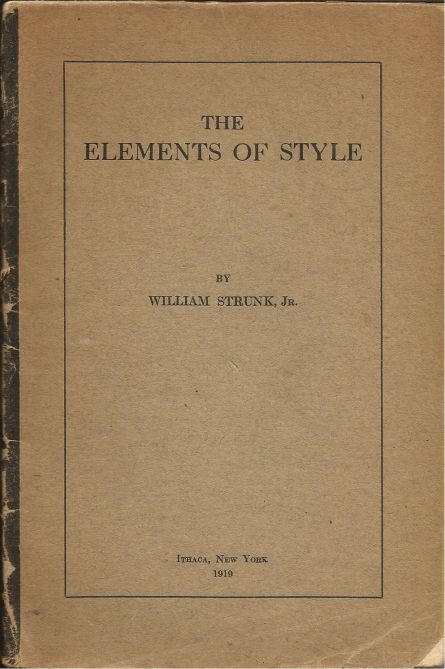At the Chronicle of Higher Education’s Lingua Franca blog, linguist Geoffrey Pullum declares, “We should not be sending students to a text as myopic and antiquated as The Elements of Style, not in any edition.” Pullum has written extensively about the failures of The Elements of Style before, and I have no problem with his criticisms, nor his crusade to make readers aware of just how weak the beloved book is, but my advice to teachers is exactly the opposite of his own. More teachers should assign The Elements of Style, especially Strunk’s out-of-copyright 1918 version available via Bartleby.com, but they should do so with the goal of having students interrogate, research, and remix the text. Such an assignment promotes active learning, because before the students can decide how to fix the text, they must first learn what is wrong with it.
I have not created such an assignment myself, but I’ve done one similar enough to have seen the benefits. When I was teaching First-Year Writing at the University of New Hampshire, I created a “Grammar Rant” assignment that asked students to analyze someone else’s rant about grammar or language. The results were wonderful, not just because the students wrote relatively good essays (though they did), but because the assignment required them to examine their own assumptions and prejudices about language and writing. Most of these students were not enthusiastic about writing or reading. They had always assumed that whatever a teacher or other person of authority told them about language was correct, and that it had been correct since the beginning of time. It was a revelation to many of my students that the “laws” of grammar and writing are, in fact, often highly contested. By becoming knowledgeable about one small area of language, style, and grammar — that is, whatever area the grammar rant they found ranted about — they began to see that they could inform themselves, make their own choices, and hold informed opinions.
Students could experience the same effect if they were assigned The Elements of Style not as an authority but as a text that, like all texts, ought to be approached with a spirit of inquiry and perhaps even skepticism. I can imagine many different progressions for such an assignment, but at the moment the one I would be tempted to try would be to assign the book and have students read around it in, looking for things they understand, don’t understand, agree with, don’t agree with, etc. Then a discussion in class of their impressions, a discussion that could dig down into how the book’s structure, language, and general rhetoric affect their reading. Do they find themselves giving in to the book’s authority or bucking against it? Why? Once those sorts of questions were exhausted, and various specific moments in the text were examined, we could then move on to some of the critiques, whether those of Pullum or Language Log or elsewhere. I would be wary of doing too much of this research for students myself. A key to the success of an assignment like this is that the students have to flounder around for a bit. They need to discover both what they know and what they don’t know, they need to encounter sources that are unreliable and sources that are more reliable, they need to brainstorm and experiment. Thus, I would assign the students (individually or in groups) to go out and look for critiques of Elements themselves, and to come back and report on what they found. Then we would assess.
After it seemed that we had assessed the critiques enough, we would then revisit our first conversation about the book and our initial response to it. Then would come the work: The original edition is out of copyright, so we can now revise and remix it. There are lots of ways to do that; I’d be inclined to have students dump the contents of the original into Pressbooks, assign groups to different chapters, and go from there.
Deliberately working with inadequate (or even outright awful!) texts requires active learning and reduces students’ belief that textbooks are always right. No longer is the student the receptacle for knowledge; instead, the student is (unavoidably!) the analyst of and catalyst for knowledge. Such learning lasts a whole lot longer than simple memorization of rules and facts, and it instills good habits of thinking, so long as the students have access to resources with which to analyze the material.
It can be good pedagogy to assign bad books.
